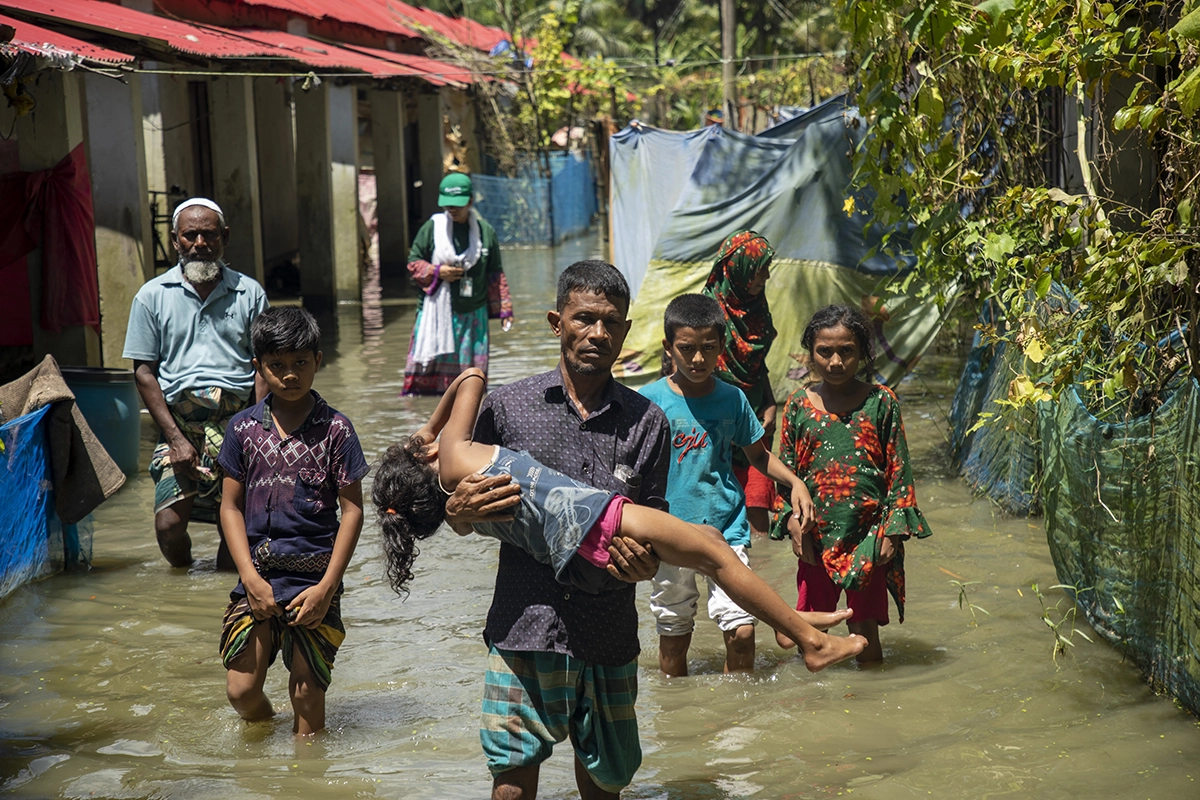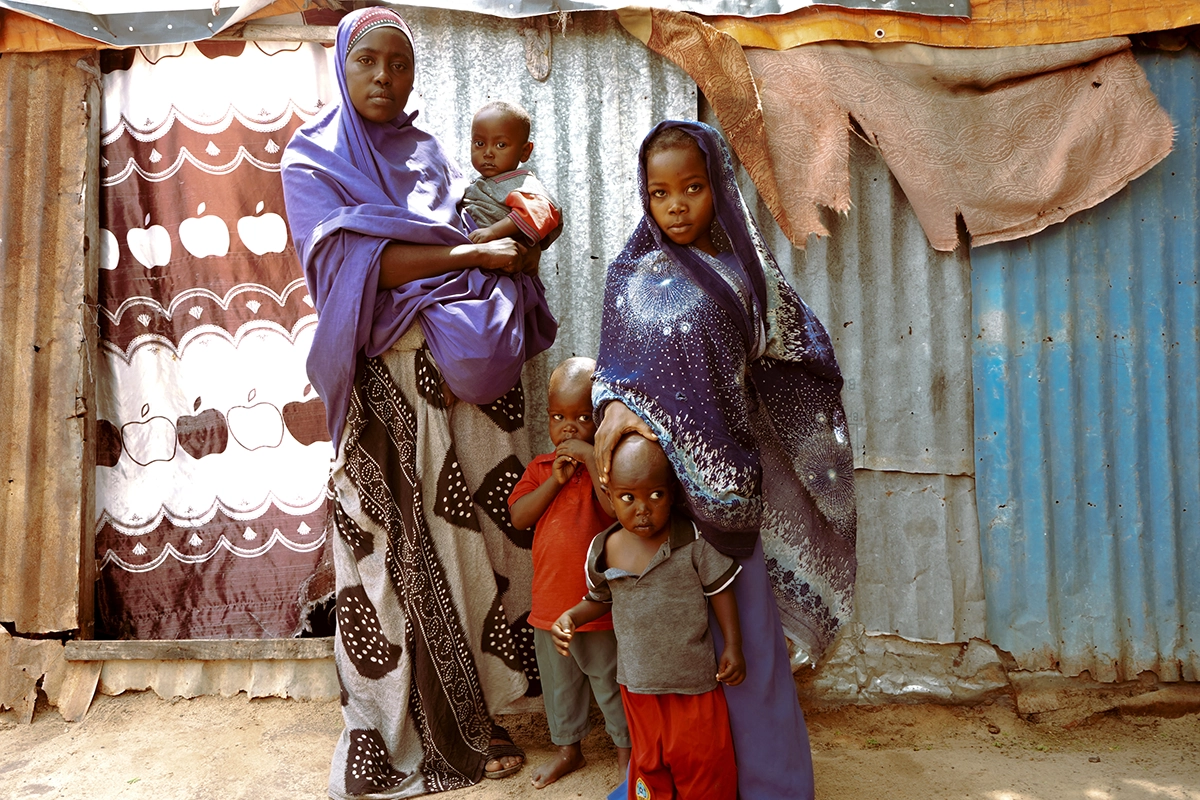What We Do
Our work: Climate & environment
Those who bear the least responsibility for climate change suffer its effects the most. Here’s what we’re doing about that.
Read MoreOver half of all internal displacements last year were due to climate change. Here’s what you need to know about “the refugees the world barely pays attention to.”
For many refugees, climate change is a reality of displacement, a factor that makes their survival that much harder-won. Rohingya refugees in climate-affected Bangladesh face the impacts of the crisis on the country, especially in increasingly severe monsoon seasons that flood camps and destroy temporary homes. The effects of climate change in Lebanon, from water stress to harsh winters, mean that over 750,000 Syrian refugees suffer biting cold spells and struggle to get clean and safe water on a regular basis.
However, climate change is not only a challenge faced by refugees. It’s also a leading cause of forced displacement, and one that we often ignore. They’ve been called “environmental refugees,” “the world’s forgotten victims,” and “the refugees the world barely pays attention to.” Here’s what you need to know about climate refugees.
Climate change is expected to be a key driver of migration and displacement in the coming decades. Now, more than any time in recorded history, people are forced to flee their homes to cope with extreme weather events; either for short-term evacuations lasting hours or days, or longer and even protracted displacement.
Shifting rainfall patterns, spreading desertification and falling agricultural productivity are likely to undermine rural livelihoods, worsen job prospects in rural areas, and accelerate the migration to urban areas. This exposes people to different risks, many that they are less able to cope with. However, mobility is also a positive coping strategy that helps people preserve their own well-being in response to both slow- and sudden-onset disasters.
The UN’s definition of a refugee is someone who has crossed an international border due to a “well-founded fear of being persecuted for reasons of race, religion, nationality, membership of a particular social group or political opinion” or conflicts and “events seriously disturbing public order.” However, climate change and conflict often go hand-in-hand, leaving many people claiming refugee status doing so because these two elements have intersected.
The United Nations High Commissioner for Refugees argues that “climate refugee” is inaccurate based on this definition, as many people fleeing the effects of climate change do not leave their own country and, based on climate events alone, generally do not face persecution. “It is more accurate to refer to ‘persons displaced in the context of disasters and climate change,’” writes the UNHCR. Shorter alternative phrases include “climate migrants” and “environmental migrants.”

This distinction, while important, has also created many problems for people forced to leave their homes due to the effects of the climate crisis. Because many climate migrants are not able to claim status as refugees or any other formal classification, historically they have not been granted protection under international law. Many of the countries hit hardest by climate change are also experiencing complex emergencies — including protracted conflict — which means that resources are limited to protect their internally-displaced populations.
In October of 2020, the UNHCR published a set of legal considerations regarding claims for international protection made in the context of the adverse effects of climate change and disasters. This acknowledges that some people may have the right to claim refugee status following a climate event or disaster based on overlapping risks to their own safety or a context that disturbs public order.
One thing the UNHCR can agree on with other organizations and news outlets is that climate change is a major driver of displacement. An estimated 30 million people are displaced annually due to climate-related disasters. In 2022, 53% of all internal displacements were driven by disasters, with 98% of those disasters linked to climate change.
Sudden disasters, including hurricanes, cyclones, tsunamis, and droughts, are a major influence. However, these are not the only way that climate change has influenced the displacement crisis: The compound interest of climate change means that people have also left home due to water shortages, increasing hunger, and other barriers to necessary natural resources.
In short, climate change has made parts of the world — areas that people have called home for millennia — uninhabitable. In Bangladesh, where 75% of the country is below sea level, rising ocean waters have uprooted and affected 25.9 million people. Estimates suggest that, by 2050, the rising sea level will submerge another 17% of the country, displacing a further 20 million.

Globally, numbers are only expected to rise — and more rapidly than ever before. The Institute for Economics and Peace estimates that, by 2050, there will be 1.2 billion people displaced around the world due to climate change and related disasters. If the global population reaches 9.9 by 2050, as predicted, that will mean 12% of the world will be climate migrants.
This is one prediction, however, and the number of climate refugees varies — in part because we don’t have a formal classification for them, and so data is very hard to standardize. The World Bank, for instance, released a report last September estimating over 200 million environmental migrants over the next thirty years. Either way, that’s a large portion of the global population.
Another World Bank report from 2018 estimated that 143 million people would be displaced by climate change in sub-Saharan Africa, South Asia, and Latin America alone. The Internal Displacement Monitoring Centre backs up this prediction. In terms of internal displacement, which accounts for much of today’s climate migration, these are the countries with the greatest number of “climate refugees,” or people displaced due to climate events and natural disasters (based on complete 2023 data):
However, climate migration is not — nor will it become — a crisis unique to these areas of the world. The United States saw over 82,000 people displaced in 2023 due to natural disasters. Since 1980, the country has sustained 400 weather and climate disasters, with damages for these disasters totaling over $2.785 trillion.

With numbers growing, climate refugees are still being ignored. “These people fall through the cracks,” Erol Yayboke of the Center for Strategic and International Studies told NPR in 2018. “It's hard for countries to come to a consensus on something like this.… The reality is there are tens of millions of these people, and we don't agree on what we can do about them.”
But governments are starting to pay attention. Just before the Paris Climate Agreement was signed in 2015, then-president of the European Union Jean-Claude Juncker called climate change “one of the root causes of a new migration phenomenon,” adding: “Climate refugees will become a new challenge if we do not act swiftly.” One of Joe Biden’s first executive orders as president in 2021 was to commission a report on climate displacement to guide future policy. “If the US defined a climate refugee, it could mark a major shift in global refugee policy,” Julie Watson wrote at the time of the report’s announcement for PBS NewsHour.
The resulting report, published by the National Security Council, was met with disappointment from policy experts. They were happy about its existence, but let down by its lack of new insights. Amali Tower, founder and executive director of advocacy group Climate Refugees, said it felt like a reiteration of what’s already known; “it doesn’t feel like it’s a step forward.”

The UN estimates that 70% of disasters are now climate-related and that, by 2030, climate change could force more than 100 million people into extreme poverty. Concern works to address this with disaster responses tailored to local environments and circumstances, working with communities to build response and resilience plans to offset the threat of future disasters, and advocating for broader climate solutions for the most vulnerable and affected people and communities at the national and international level.
Some of our key programs, including Climate Smart Agriculture (CSA) and Disaster Risk Reduction (DRR), are examples of these solutions in action. We have also adapted other initiatives, like the livelihoods-building Graduation and our standard-setting Community Management of Acute Malnutrition (CMAM), to align with the realities faced by people in areas affected by climate change.
Nearly every country we work in involves some form of climate response. Last year, we had programs in 16 countries implementing climate resilience, more than doubling reach compared to the previous year. Learn more about our country-specific approaches and programs below.